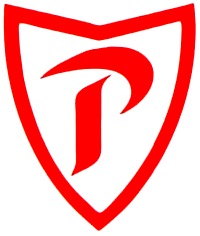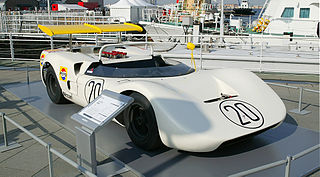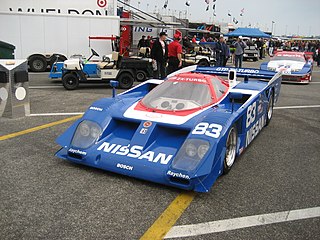
A sports car is a car designed with an emphasis on dynamic performance, such as handling, acceleration, top speed, the thrill of driving, and racing capability. Sports cars originated in Europe in early 1910s and are currently produced by many manufacturers around the world.

The Nissan Skyline GT-R is a Japanese sports car based on the Nissan Skyline range. The first cars named "Skyline GT-R" were produced between 1969 and 1972 under the model code KPGC10, and were successful in Japanese touring car racing events. This model was followed by a brief production run of second-generation cars, under model code KPGC110, in 1973.

Nissan Motorsports International, abbreviated as Nismo, is a division of Nissan Motorsports & Customizing focused in motorsport and performance-oriented car models for Nissan. Nismo was initially a company, Nissan Motorsports International Co., Ltd., formed in 1984 as a result of a merger of two motorsport departments, being the in-house tuning, motorsports and performance subsidiary of Nissan. It has competed in JSPC, JTCC, the 24 Hours of Le Mans and the 24 Hours of Daytona. They currently participate in Super GT and Formula E. Nismo ceased to be a company in April 2022 by being merged with sister company Autech into a new Nissan subsidiary, Nissan Motorsport & Customizing.

The Nissan Skyline is a brand of automobile originally produced by the Prince Motor Company starting in 1957, and then by Nissan after the two companies merged in 1967. After the merger, the Skyline and its larger counterpart, the Nissan Gloria, were sold in Japan at dealership sales channels called Nissan Prince Shop. Starting with the Third Generation C10, the chassis, suspension and some of the engines were shared with the longer wheelbase Nissan Laurel from 1968-2002, when the formerly Prince factory at Musashimurayama was closed, and the Skyline shared its platform with the Nissan 350Z.

The Toyota 2000GT is a limited-production front mid-engine, rear-wheel-drive, two-door, two-seat sports car/grand tourer designed by Toyota in collaboration with Yamaha. First displayed to the public at the Tokyo Motor Show in 1965, the 2000GT was manufactured under contract by Yamaha between 1967 and 1970. A halo car for the automaker, in Japan it was exclusive to Toyota's Japanese retail sales channel called Toyota Store.

The Nissan S30, sold in Japan as the Nissan Fairlady Z and in other markets as the Datsun 240Z, then later as the 260Z and 280Z, is a grand tourer produced by Nissan from 1969 until 1978. The S30 was conceived of by Yutaka Katayama, the President of Nissan Motor Corporation U.S.A., and designed by a team led by Yoshihiko Matsuo, the head of Nissan's Sports Car Styling Studio. It is the first car in Nissan's Z series of sports cars.

The Prince Motor Company was an automobile marque from Japan which eventually merged into Nissan in 1966. It began as the Tachikawa Aircraft Company, a manufacturer of various airplanes for the Japanese Army in World War II, e.g., the Ki-36, Ki-55 and Ki-74. Tachikawa Aircraft Company was dissolved after the war and the company took the name Fuji Precision Industries. It diversified into automobiles, producing an electric car, the Tama, in 1946, named for the region the company originated in, Tama, using the Ohta series PC/PD platform. The company changed its name to Prince in 1952 to honor Akihito's formal investiture as Crown Prince of the nation. In 1954 they changed their name back to Fuji Precision Industries, and in 1961 changed the name back again to Prince Motor Company. In 1966, they became part of Nissan, while the Prince organization remained in existence inside Nissan, as Nissan Prince Store in Japan until Nissan consolidated the Prince dealership network into "Nissan Blue Stage" in 1999.

The Prince G-series engine was the company's only straight-four and straight-six engines which began production in 1955. A number of variations were made, with both OHV and OHC heads. A diesel four-cylinder with 1.9 L (1,862 cc) was also built, called the D-6. The G series was used in the Skyline, the Laurel, and the Gloria from the 1950s to the early 1970s.

The Gloria is a large luxury car made from 1959 by the Prince Motor Company, and later by Nissan Motors since its merger with the former - hence being originally marketed as Prince Gloria and later as Nissan Gloria. Initially based on the smaller Prince Skyline, the Gloria line was merged with Nissan Cedric starting with 1971 models and both continued until 2004, when they were both replaced by Nissan Fuga.

The Nissan S20 engine 2.0 L (1,989 cc) was a straight-6 four-valve DOHC internal combustion engine produced by Nissan from 1969 to 1973, originally designed by engineers of the former Prince. It was the first mass-produced Japanese engine with more than two valves per cylinder.

The Nissan R390 GT1 was a racing car built in Atsugi, Japan. It was designed primarily to gain a suitable racing entry in the 24 Hours of Le Mans in 1997 and 1998. It was built to race under the grand touring style rules, requiring a homologated road version to be built. Therefore, the R390 was built originally as road car, then a racing version of the car was developed afterwards. Only one R390 road car was ever built and is stored at Nissan's Zama facility, although one of the race cars was later modified for road use. The road car was claimed to be capable of attaining a top speed of 354 km/h (220 mph). However, this claim has never been proven.

The Nissan R381 was a racing car developed by Nissan Motors in 1968 for use in the Japanese Grand Prix. It was the successor to the Nissan R380-II, which had been originally developed by the Prince Motor Company

The Nissan R382 was a racing car built in 1969 by Nissan Motors for competition in the Japanese Grand Prix. Built to the Group 7 motorsports formula, the car featured Nissan's first V12 engine. It was a replacement for the Nissan R381 from the previous year.

The Nissan R383 was a race car built in 1970 by Nissan Motors that was planned for use in the 1970 Japanese Grand Prix. Replacing the Nissan R382, it would be the final racing sportscar built by Nissan until the mid-1980s.

The Nissan GTP ZX-Turbo was a series of racing cars developed for Nissan Motors by Electramotive Engineering to compete in the IMSA GT Championship. Running from 1985 to 1990, they were known for being the first car to defeat the Porsche 962 which had dominated IMSA's premiere GTP category. This led to Nissan winning the constructor's championship and 12 Hours of Sebring in 1989 and 1990. During 1990, the GTP ZX-Turbo was replaced by the newer NPT-90.

The Toyota 7 was a series of racing cars developed by Toyota Motor Company in cooperation with Yamaha Motor Corporation. Designed primarily for use in FIA Group 7 competition, it was Toyota's first purpose-built racing car project.

Kozo Watanabe is a Japanese automotive engineer who was responsible for the development of the ninth generation Nissan Skyline (R33) and the tenth generation Nissan Skyline (R34).

The Nissan Heritage Collection is a private car gallery located in the Nissan engine manufacturing plant in Zama, Kanagawa, Japan.
Tetsu Ikuzawa is a Japanese former racing driver, team executive, and businessman from Tokyo, Japan. He is one of the most successful and prolific Japanese drivers from the early years of the nation's automobile racing history. Ikuzawa was the first Japanese driver to regularly compete in a number of notable European championships, namely the British Formula Three Championship and European Formula Two Championship. He was also one of the first Japanese drivers to compete in the 24 Hours of Le Mans endurance race, making his first start in 1973 for Sigma Automotive alongside his countryman, Hiroshi Fushida. In domestic competition, Ikuzawa won the 1964 and 1967 Japanese Grand Prix sports car races, and the 1977 Fuji Grand Champion Series.

Yoshikazu Sunako was a Japanese motorcycle racer and racing driver.






















